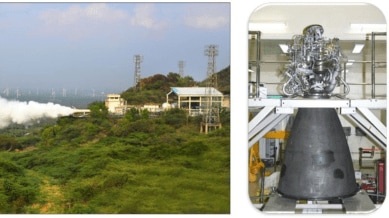Stay updated with the latest - Click here to follow us on Instagram
ISRO successfully performs engine restart test on CE-20 of Gaganyaan Mission’s launch vehicle
The 10-second-long test was conducted at Isro's Propulsion Complex at Mahendragiri, Tamil Nadu, on November 7.

In what is possibly the first in the world, the Indian Space Research Organisation (Isro) successfully performed the boot-strap mode start test on a cryogenic engine, CE-20, without any auxiliary start-up system.
The 10-second-long test was conducted at the space agency’s Propulsion Complex at Mahendragiri, Tamil Nadu, on November 7.
“We successfully demonstrated the boot-strap mode build-up and steady-state operation of the engine,” Isro said in a statement.
The intermediary step to the CE-20 cryogenic engine of the Launch Vehicle Mark-3 (LVM) will be crucial for India’s Gaganyaan mission and the Bharatiya Antariksh Station (BAS), which requires multi-orbital and multi-restart of the engines. This engine had previously qualified for the Gaganyaan missions, and the vehicle had qualified for operating at thrust levels between 19 and 22 tonnes in flight with a single start.
This step, when introduced to engine operations, is capable of boosting the payload-carrying capacity of large space vehicles, as it would aid in the flight restarting of engines without any additional load or setup.
The test
A multi-element igniter was employed in both the thrust chamber and gas generator to facilitate boot-strap starting. After ignition of the thrust chamber, the gas generator was ignited under tank head conditions, and the turbo pumps were started, without the use of the start-up system.
A space launch vehicle’s strength lies in its payload-carrying capacity, as it is the basis upon which the mission life and mission objectives rest.
Isro-developed CE-20 powers the upper stage of the LVM3, with a lift-off capacity of 4,000 tonnes. This is a three-stage launch vehicle: two solid strap-on motors carrying up to 204 tonnes of solid propellant; one liquid core stage with twin engines carrying 115 tonnes of liquid propellant, and lastly, the high-thrust cryogenic upper stage, carrying 28 tonnes of propellant.
During nominal operation, the engine ignition is initiated under tank head conditions, followed by the start of turbopumps using a stored gas start-up system.
According to Isro, future missions designed to have multiple in-flight restarts of the CE20 engine will require flexibility towards multi-orbit missions.
“However, in the present configuration, each restart demands an additional start-up gas bottle and associated systems, leading to a reduction in vehicle payload capability. Hence, achieving boot-strap mode start – where the engine builds up to steady operation without external start-up assistance – was essential,” Isro stated.